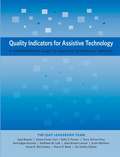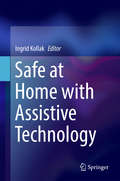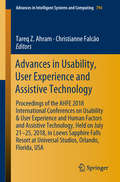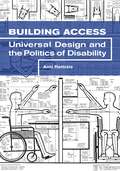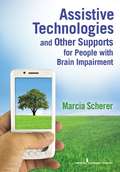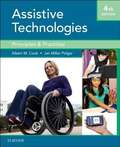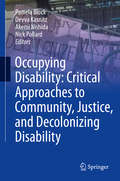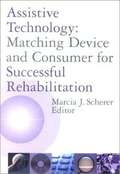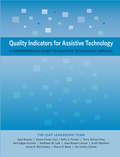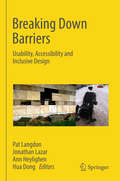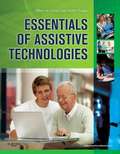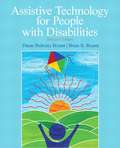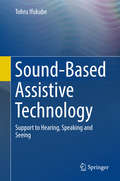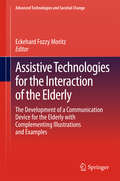Special Collections
Assistive Technology
Description: A diverse collection of textbooks detailing assistive technology for people with a diverse range of disabilities. #disability
- Table View
- List View
Quality Indicators For Assistive Technology
by The QIAT Leadership TeamMore than 6 million children with disabilities in North America require assistive technology and related services each year in order to participate and succeed in school. This book, Quality Indicators for Assistive Technology, provides an essential guide for assessing a child's needs, choosing and implementing the right technologies and services, and training education professionals in how to optimize learning with these critical tools.
Safe at Home with Assistive Technology
by Ingrid KollakThis book describes how assistive technology can help handicapped, elderly and acutely sick people to manage their daily lives better and stay safe in the home. It discusses how safety is understood from an ethical, technical and social perspective, and offers examples of the problems that users, their helpers and professional carers have with assistive technology in everyday situations. The book provides insights from user-centred research and uses photographs to illustrate the main topic: how users and technology can work together to ensure safety. User-focused and combining experience with research, the book will interest users of these kinds of technology, health professionals who might introduce and/or prescribe them, engineers who develop and sell assistive technological gadgets, and architects who build safe homes - as well as researchers and students who work in these fields. It provides an overview of the existing technology, examines ways to test its effectiveness from the point of view of users, health professionals and researchers from different fields (architecture, education, engineering, facility management, medicine, nursing, occupational therapy, rehabilitative medicine, physiotherapy, social science and speech therapy), and lists useful addresses, websites and literature
Advances in Usability, User Experience and Assistive Technology
by Tareq Z. Ahram and Christianne FalcãoThis book focuses on emerging issues in usability, interface design, human–computer interaction, user experience and assistive technology. It highlights research aimed at understanding human interaction with products, services and systems, and focuses on finding effective approaches for improving user experience. It also discusses key issues in designing and providing assistive devices and services to individuals with disabilities or impairment, to assist mobility, communication, positioning, environmental control and daily living. The book covers modelling as well as innovative design concepts, with a special emphasis on user-centered design, and design for specific populations, particularly the elderly. Virtual reality, digital environments, heuristic evaluation and forms of device interface feedback of (e.g. visual and haptic) are also among the topics covered. Based on the AHFE 2018 Conference on Usability & User Experience and the AHFE 2018 Conference on Human Factors and Assistive Technology, held on July 21–25, 2018, in Orlando, Florida, USA, this book reports on cutting-edge findings, research methods and user-centred evaluation approaches.
Building Access
by Aimi Hamraie&“All too often,&” wrote disabled architect Ronald Mace, &“designers don&’t take the needs of disabled and elderly people into account.&” Building Access investigates twentieth-century strategies for designing the world with disability in mind. Commonly understood in terms of curb cuts, automatic doors, Braille signs, and flexible kitchens, Universal Design purported to create a built environment for everyone, not only the average citizen. But who counts as &“everyone,&” Aimi Hamraie asks, and how can designers know? Blending technoscience studies and design history with critical disability, race, and feminist theories, Building Access interrogates the historical, cultural, and theoretical contexts for these questions, offering a groundbreaking critical history of Universal Design. Hamraie reveals that the twentieth-century shift from &“design for the average&” to &“design for all&” took place through liberal political, economic, and scientific structures concerned with defining the disabled user and designing in its name. Tracing the co-evolution of accessible design for disabled veterans, a radical disability maker movement, disability rights law, and strategies for diversifying the architecture profession, Hamraie shows that Universal Design was not just an approach to creating new products or spaces, but also a sustained, understated activist movement challenging dominant understandings of disability in architecture, medicine, and society.Illustrated with a wealth of rare archival materials, Building Access brings together scientific, social, and political histories in what is not only the pioneering critical account of Universal Design but also a deep engagement with the politics of knowing, making, and belonging in twentieth-century United States.
Disability and Information Technology
by Eliza VarneyDisability and Information Technology examines the extent to which regulatory frameworks for information and communication technologies (ICTs) safeguard the rights of persons with disabilities as citizenship rights. It adopts a comparative approach focused on four case studies: Canada, the European Union, the United Kingdom and the United States. It focuses on the tension between social and economic values in the regulation of ICTs and calls for a regulatory approach based on a framework of principles that reflects citizenship values. The analysis identifies challenges encountered in the jurisdictions examined and points toward the rights-based approach advanced by the UN Convention on the Rights of Persons with Disabilities as a benchmark in protecting the rights of persons with disabilities to have equal access to information. The research draws on a wealth of resources, including legislation, cases, interviews, consultation documents and responses from organisations representing persons with disabilities.
Safe at Home with Assistive Technology
by Ingrid KollakThis book describes how assistive technology can help handicapped, elderly and acutely sick people to manage their daily lives better and stay safe in the home. It discusses how safety is understood from an ethical, technical and social perspective, and offers examples of the problems that users, their helpers and professional carers have with assistive technology in everyday situations. The book provides insights from user-centred research and uses photographs to illustrate the main topic: how users and technology can work together to ensure safety. User-focused and combining experience with research, the book will interest users of these kinds of technology, health professionals who might introduce and/or prescribe them, engineers who develop and sell assistive technological gadgets, and architects who build safe homes – as well as researchers and students who work in these fields. It provides an overview of the existing technology, examines ways to test its effectiveness from the point of view of users, health professionals and researchers from different fields (architecture, education, engineering, facility management, medicine, nursing, occupational therapy, rehabilitative medicine, physiotherapy, social science and speech therapy), and lists useful addresses, websites and literature
Assistive Technologies and Other Supports for People With Brain Impairment
by Marcia J. SchererAssistive Technologies and Other Support for People with Brain Impairment, by Marcia J. Scherer, is a must-have text for academic instructors and their students. The author's synopsis of brain impairment, current rehabilitation strategies, available assistive technologies and resources, as well as the practical merging of the above, makes this an invaluable addition to any academic program in cognitive rehabilitation. This book gives a clear and detailed overview of how the brain reacts to impairment and gives illustrated examples of effective integration of AT into the lives of people with cognitive disability. Integrating current research with the experiences of people with cognitive disabilities, this volume examines how assistive and cognitive support technologies are being harnessed to provide assistance for thinking, remembering, and learning. The book vividly describes real-life situations in which cognitively impaired individuals use assistive supports and the advantages and limitations these individuals perceive from their use. It provides information on how cognitively impaired individuals and their families and caregivers can select the most appropriate technologies from a wide array of accommodations and resources, including individualized protocols of different forms of support to facilitate optimal functioning. The text offers practitioners a comprehensive and systematic process for ensuring their clients' effective application and utilization of this technology. This book will also provide insight for users of assistive technology and their families and caregivers to ensure optimal technology use.
Assistive Technologies
by Albert M. Cook and Janice Miller PolgarIt's here: the latest edition of the one text you need to master assistive strategies, make confident clinical decisions, and help improve the quality of life for people with disabilities. Based on the Human Activity Assistive Technology (HAAT) model, Assistive Technologies: Principles and Practice, 4th Edition provides detailed coverage of the broad range of devices, services, and practices that comprise assistive technology, and focuses on the relationship between the human user and the assisted activity within specific contexts. Updated and expanded, this new edition features coverage of new ethical issues, more explicit applications of the HAAT model, and a variety of global issues highlighting technology applications and service delivery in developing countries. Human Activity Assistive Technology (HAAT) framework demonstrates assistive technology within common, everyday contexts for more relevant application. Focus on clinical application guides you in applying concepts to real-world situations. Review questions and chapter summaries in each chapter help you assess your understanding and identify areas where more study is needed. Content on the impact of AT on children and the role of AT in play and education for children with disabilities demonstrates how AT can be used for early intervention and to enhance development. Coverage of changing AT needs throughout the lifespan emphasizes how AT fits into people's lives and contributes to their full participation in society. Principles and practice of assistive technology provides the foundation for effective decision-making. NEW! Global issues content broadens the focus of application beyond North America to include technology applications and service delivery in developing countries. NEW! Ethical issues and occupational justice content exposes you to vital information as you start interacting with clients. NEW! More case studies added throughout the text foster an understanding of how assistive technologies are used and how they function. NEW! Updated content reflects current technology and helps keep you current. NEW! Explicit applications of the HAAT model in each of the chapters on specific technologies and more emphasis on the interactions among the elements make content even easier to understand.
Occupying Disability
by Pamela Block and Devva Kasnitz and Akemi Nishida and Nick PollardThis book explores the concept of "occupation" in disability well beyond traditional clinical formulations of disability: it considers disability not in terms of pathology or impairment, but as a range of unique social identities and experiences that are shaped by visible or invisible diagnoses/impairments, socio-cultural perceptions and environmental barriers and offers innovative ideas on how to apply theoretical training to real world contexts. Inspired by disability justice and "Disability Occupy Wall Street / Decolonize Disability" movements in the US and related movements abroad, this book builds on politically engaged critical approaches to disability that intersect occupational therapy, disability studies and anthropology. "Occupying Disability" will provide a discursive space where the concepts of disability, culture and occupation meet critical theory, activism and the creative arts. The concept of "occupation" is intentionally a moving target in this book. Some chapters discuss occupying spaces as a form of protest or alternatively, protesting against territorial occupations. Others present occupations as framed or problematized within the fields of occupational therapy and occupational science and anthropology as engagement in meaningful activities. The contributing authors come from a variety of professional, academic and activist backgrounds to include perspectives from theory, practice and experiences of disability. Emergent themes include: all the permutations of the concept of "occupy," disability justice/decolonization, marginalization and minoritization, technology, struggle, creativity and change. This book will engage clinicians, social scientists, activists and artists in dialogues about disability as a theoretical construct and lived experience.
Assistive Technology
by Marcia J. SchererAn exploration of the ways in which psychologists and other helping professionals can collaborate with users of assistive technology to help them get the most out of these devices.
Quality Indicators for Assistive Technology
by Susan Mccloskey and Diana Foster Carl and Gayl Bowser and Jane Edgar Korsten and Joan Breslin Larson and Joy Smiley Zabala and Kathleen Lalk and Kelly Fonner and Penny Reed and Scott Marfilius and Terry Vernon FossMore than 6 million children with disabilities in North America require assistive technology and related services each year in order to participate and succeed in school. This book, Quality Indicators for Assistive Technology, provides an essential guide for assessing a child's needs, choosing and implementing the right technologies and services, and training education professionals in how to optimize learning with these critical tools.
Breaking Down Barriers
by Hua Dong and Ann Heylighen and Jonathan Lazar and Pat LangdonThe Cambridge Workshops on Universal Access and Assistive Technology (CWUAAT) is one of the few gatherings where people interested in inclusive design, across different fields, including designers, computer scientists, engineers, architects, ergonomists, ethnographers, policymakers and user communities, meet, discuss, and collaborate. CWUAAT has also become an international workshop, representing diverse cultures including Portugal, Germany, Trinidad and Tobago, Canada, Australia, China, Norway, USA, Belgium, UK, and many more. The workshop has five main themes based on barriers identified in the developing field of design for inclusion: I Breaking Down Barriers between Disciplines II Breaking Down Barriers between Users, Designers and Developers III Removing Barriers to Usability, Accessibility and Inclusive Design IV Breaking Down Barriers between People with Impairments and Those without V Breaking Down Barriers between Research and Policy-making In the context of developing demographic changes leading to greater numbers of older people and people living with impairments, the general field of inclusive design research strives to relate the capabilities of the population to the design of products, services, and spaces. CWUAAT has always had a successful multidisciplinary focus, but if genuine transdisciplinary fields are to evolve from this, the final barriers to integrated research must be identified and characterised. Only then will benefits be realised in an inclusive society. Barriers do not arise from impairments themselves, but instead, are erected by humans, who often have not considered a greater variation in sensory, cognitive and physical user capabilities. Barriers are not only technical or architectural, but they also exist between different communities of professionals. Our continual goal with the CWUAAT workshop series is to break down barriers in technical, physical, and architectural design, as well as barriers between different professional communities.
Essentials of Assistive Technologies
by Albert M. Cook and Jan Millar PolgarMaster the assistive strategies you need to make confident clinical decisions and help improve the quality of life for people with disabilities with this new essentials text. Based on the Human Activity Assistive Technology (HAAT) model developed by Dr. Cook, the book provides the most important coverage of the devices, services, and practices that comprise assistive technology and focuses on the relationship between the human user and the assisted activity within specific contexts. Case studies, illustrations of assistive devices, review questions, and well-developed learning objectives help you focus on the most important areas of assistive technology application.
Assistive Technology For People With Disabilities (Second Edition)
by Diane Pedrotty Bryant and Brian R. BryantAssistive Technology for People with Disabilities, Second Edition, includes eight comprehensive chapters that focus on devices and software to enhance the lives and promote the independence of people with disabilities. Updated with new research, content and features to address current developments in the field, the book approaches assistive technology and education in a lifespan, multidisciplinary manner by discussing the use of current technology in the fields of special education, rehabilitation, speech-language pathology, and other disciplines. Featured devices and software will help you understand how areas such as mobility, communication, education, independent living, and access to information media affect learning and living for individuals with disabilities. You will also gain a great understanding of the foundational and historical perspectives of AT, assessment, universal design, and the ADAPT framework, which is a tool to help educators make decisions about appropriate AT, student needs, and the demands of the environment. Developed from the authors' years of experience teaching both K-12 students and adults, as well as their own framework for understanding assistive technology application and integrating technology into instruction, this new edition addresses assistive technology that promotes knowledge and skills, practical application and a myriad of opportunities that good technology provides for persons with disabilities.
Sound-Based Assistive Technology
by Tohru IfukubeThis book presents a technology to help speech-, hearing- and sight-impaired people. It explains how they will benefit from an enhancement in their ability to recognize and produce speech or to detect sounds in their surroundings. Additionally, it is considered how sound-based assistive technology might be applied to the areas of speech recognition, speech synthesis, environmental recognition, virtual reality and robots. The primary focus of this book is to provide an understanding of both the methodology and basic concepts of assistive technology rather than listing the variety of assistive devices developed. This book presents a number of different topics which are sufficiently independent from one another that the reader may begin at any chapter without lacking background information. Much of the research quoted in this book was conducted in the author's laboratories at Hokkaido University and University of Tokyo. This book offers the reader a better understanding of a number of unsolved problems that still persist in the field of sound-based assistive technology.
Assistive Technologies for the Interaction of the Elderly
by Eckehard Fozzy MoritzThis book presents a wealth of insights and new conceptualizations for the development of Assistive Technologies for the Interaction of the Elderly. The book arranges the chapters according to important aspects of maximizing the use value in innovation projects. Every chapter will include an executive summary reporting the main results, a storyline using everyday language, and scientific excursions, wherever useful. The book shows how an innovation project should be structured towards maximum use value and how a project should be structured in order to make a difference. It describes the useful categorization of the large group of the elderly to maximize the focus of the innovation and demonstrates the user involvement into innovation activities. Of course, the assessment of such innovative projects is discussed as well as the "lessons learned". The book also explores the business opportunities and the financial evaluation of aspects of assistive technology.
Assistive Technology For Young Children
by Nancy B. Robinson and Kathleen Curry SadaoThis book appeals to the needs of a wide range of readers who seek to increase their technology competencies in order to improve access to learning for children with disabilities.
